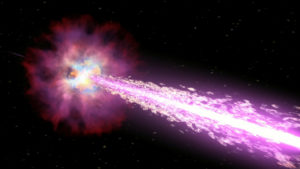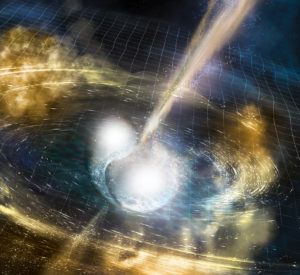Pulsars
People involved: Cees Bassa, Vlad Kondratiev, Anya Bilous, Jason Hessels, Joeri van Leeuwen, Gemma Janssen, Emma van der Wateren
Pulsar Searching
At ASTRON, we are always searching for new pulsars --- fast spinning highly magnetised neutron stars --- with the goal of finding systems that challenge our current understanding of neutron stars or provide new avenues for testing fundamental physical theories. Using the LOFAR telescope, we are conducting an all- sky survey for pulsars, which has led to the discovery of the slowest-spinning radio pulsar know to date. This source spins more than 10 times slower than a typical pulsar and provides new insight into how various sub-classes of neutron stars are linked and evolve during their lives.
At the same time, we are also using LOFAR to target sources of high-energy gamma ray emission discovered with NASA’s Fermi gamma-ray telescope. This has led to the LOFAR discovery of the fastest-spinning radio pulsar in the Galactic field. Such sources are spun-up by the transfer of material from a companion star and rotate hundreds of times per second. Further searches have the goal of discovering a neutron star that spins so rapidly that we can tightly constrain its size and hence the properties of its hyper-dense interior. This is of great interest to astrophysicists and nuclear physicists alike.
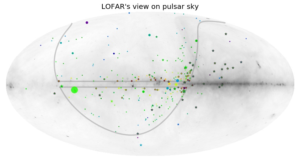
Pulsar Population and Emission Mechanism
Radio pulsars manifest great variety of observational phenomena, such as drifting subpulses, nulling, mode switching, bright individual pulses or giant pulses, and many others. Studying them allows to challenge the existing theories of pulsar radio emission and its interaction with magnetospheric plasma and fields. It's been more than 50 years since the discovery of pulsars by Jocelyn Bell in 1967, but despite significant effort astronomers still do not have the complete understanding of how these fascinating objects work. However, the most of the studies so far were carried out at frequencies around 1 GHz or higher where the distortion of the pulsar emission caused by propagation effects by interstellar medium is small. Low-frequency wide band observations, on the other hand, should provide better look on how the properties (such as polarisation and changes in amplitude, shape, phase of profile's components) evolve with frequency. Using the LOFAR telescope, astronomers at ASTRON and other institutes have already carried out a number of studies of pulsar properties at low frequencies including the characterisation of known millisecond and slow pulsar populations at low frequencies, providing reliable estimates on pulsar dispersion measures, flux densities and spectra. The current focus is to improve the polarisation calibration of LOFAR especially at the very low frequencies below 100 MHz in order to get reliable estimates of polarisation properties of pulsars and it's evolution across the LOFAR band.
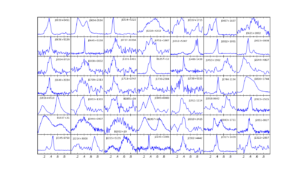
Fast Radio Bursts
People involved: Cees Bassa, Jason Hessels, Sander ter Veen, Joeri van Leeuwen
In our largely unchanging radio Universe, a highly dynamic component was recently discovered: flashes of bright radio emission that last only milliseconds but appear all over the sky. Due to great observational challenges, the exact nature of these extragalactic fast radio bursts (FRBs) remains mysterious. At ASTRON, we aim to understand the physics that drives these brief and luminous bursts. To this end, we are conducting a survey for fast radio bursts with the APERTIF receiver on the Westerbork Synthesis Radio Telescope. We are also conducting high angular resolution observations of repeating fast radio bursts with the European VLBI Network (EVN) to localise them within their host galaxies. EVN and stand-alone data from some of the Westerbork dishes are also being used to obtain sub-microsecond resolution to study the fine structure in FRB sources.
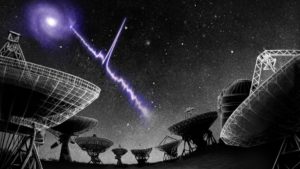
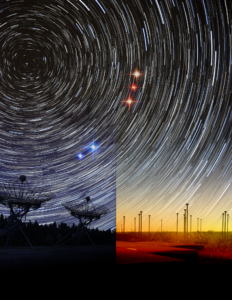
NANOHERTZ GRAVITATIONAL WAVES
People involved: Gemma Janssen
Some pulsars are very stable clocks with each tick of the clock being the arrival of a radio pulse. These clocks can be used to accurately measure changes in the time taken by the pulsar radio pulses to travel to the Earth, a technique called pulsar timing. Because gravitational waves stretch and squeeze space they leave a distinct signature in pulsar timing observations as shown in the image below. Such observations essentially create a gravitational wave detector that is the size of our Galaxy and are sensitive to gravitational waves with frequencies in the nanoHertz regime caused by the merger of supermassive black holes in the Universe. This is complementary to higher frequency gravitational waves caused by mergers of lower-mass objects that are detected by LIGO and VIRGO. Pulsar timing may also discover more exotic gravitational wave sources can such as inflation, phase transitions in the early universe, or the effects of cosmic strings that are predicted by gravitational string theories.
Our group collaborates with an international team of pulsar astronomers and aims to make a first detection of these gravitational waves. We combine observations from several observatories including from our own Westerbork telescopes that are part of the European Pulsar Timing Array and the International Pulsar Timing Array Projects. Separately, the pulsars group also endeavour to find new pulsars that can serve as accurate clocks via large-scale pulsar surveys such as the LOFAR Tied-Array All-sky Survey (LOTAAS).
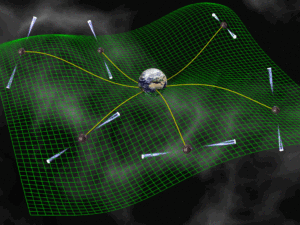
RELATIVISTIC EXPLOSIONS
People involved: Antonia Rowlinson
Our Universe is highly dynamic and variable, with many sources going into outburst or cataclysmic explosions happening every day. These outbursts and explosions provide deep insights into the most extreme environments in the Universe, often probing the most intense gravitational and magnetic fields. The binary mergers of black holes and neutron stars are an exciting new field of study, with their counterparts now being observed in both gravitational waves and electromagnetic waves. Gamma-ray bursts, tidal disruption events and supernovae produce copious amounts of electromagnetic emission resulting from the deaths of massive stars and/or extreme accretion onto a black hole. Within our own Galaxy, there are many sources such as flare stars and X-ray binaries that produce highly variable electromagnetic emission.
At ASTRON, we utilize the radio emission from these extreme objects to understand the emission processes, macro-physics and the interstellar medium associated with these events. We conduct large imaging surveys using world class radio telescopes, including LOFAR and MeerKAT, to find and quantify new populations of transient events. Additionally, we obtain triggered observations to target sources detected at other observing frequencies or via their gravitational wave emission.
